Tuscan Cuisine: Unveiling the Treasures of Regional Cuisine
Dive into Tuscan Culinary Delights: Unveiling the Region's Signature Dishes
Tuscany is a rural land. In Tuscany, there are treasures guarded in austere museums or available to everyone, strolling through the streets of our beautiful cities. Some treasures are in the pantries of kitchens, as I explain in this article, and you can savor them combined in culinary specialties rich in genuine flavors. Let's explore together some typical dishes from my beautiful region that you can enjoy during your stay at La Scuola di Furio. Remember that I, my brother, my parents, and my grandparents were born in Tuscany, so Walter and I, being "good eaters," understand it well and are always available if you want advice on where to go to eat a certain specialty. We are always happy when our guests return to La Scuola di Furio and say, "Walter, Tiziana, we want to eat an excellent steak, can you book us in the restaurant you recommended last year?"
Tuscany offers a wide range of dishes for all tastes. The rural Tuscany is found in many traditional dishes. Let's see some, divided as if we were at a restaurant: appetizers, first courses, second courses, single dishes, and desserts. I remind you that typical Tuscan cuisine is fundamentally "from the garden" and "recycled," so it is very relevant in these times when we have rediscovered the importance of the environment, and even vegetarians and vegans can find characteristic dishes to their liking among our typical dishes.
STARTERS
Crostini toscani
Simple and made with chicken innards. Unsalted Tuscan bread and chicken liver sauce. A typical recipe of peasant origin, also called "black crostini," they are still prepared throughout Tuscany, with numerous variations. The classic preparation involves using only chicken livers. To a base of sauté (in a pan, heat a tablespoon of extra virgin olive oil per diner. Put in the pan the vegetables - onion, carrot, celery - that you have finely chopped with a knife. Sauté gently. The sauté will be ready when the onion is golden and soft), add the cleaned, defatted, and ground livers. Deglaze with wine (some use Vin Santo). Spread the obtained sauce on a crostino of hard bread (my grandfather Spartaco loved crostini soaked with broth, a delight that we always used to have at Christmas!) and the dish is ready. Some do not like this dish because they feel a too strong liver taste. If this happens, it may be due to livers not defatted properly; a good crostino should never taste too much of liver.
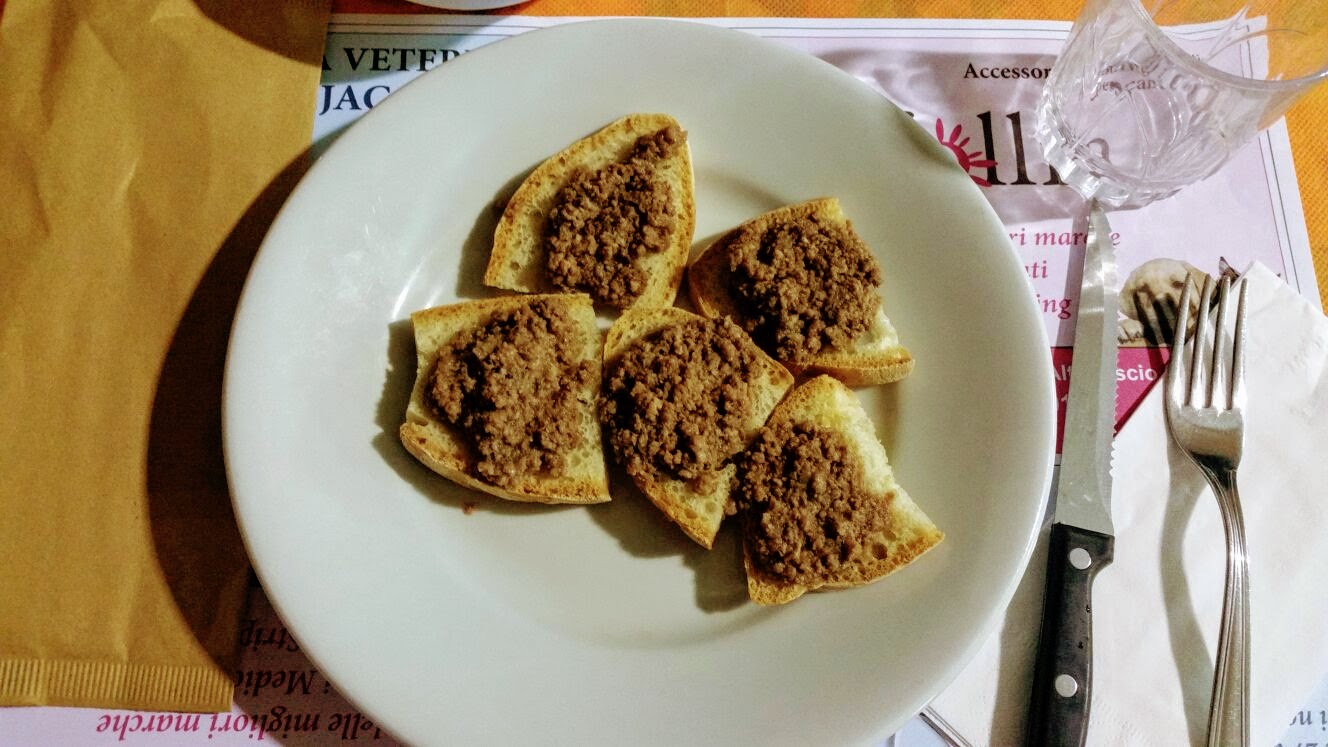
Crostini toscani - Sagra della Polenta a Palle
Fettunta
In my childhood memories, a simplified version of fettunta was a homemade snack (well, at that time, snacks were a luxury). Today, fettunta is a small great classic for everyone, especially when there is new oil in autumn, and everyone gathers around the table to taste the harvested olives. It consists of simple slices of bread toasted on the grill, rubbed if you want with garlic, and generously sprinkled with extra virgin olive oil, salt, and, if desired, pepper. It is ideal to consume them while still warm, but usually, there is no danger; they disappear in a flash!
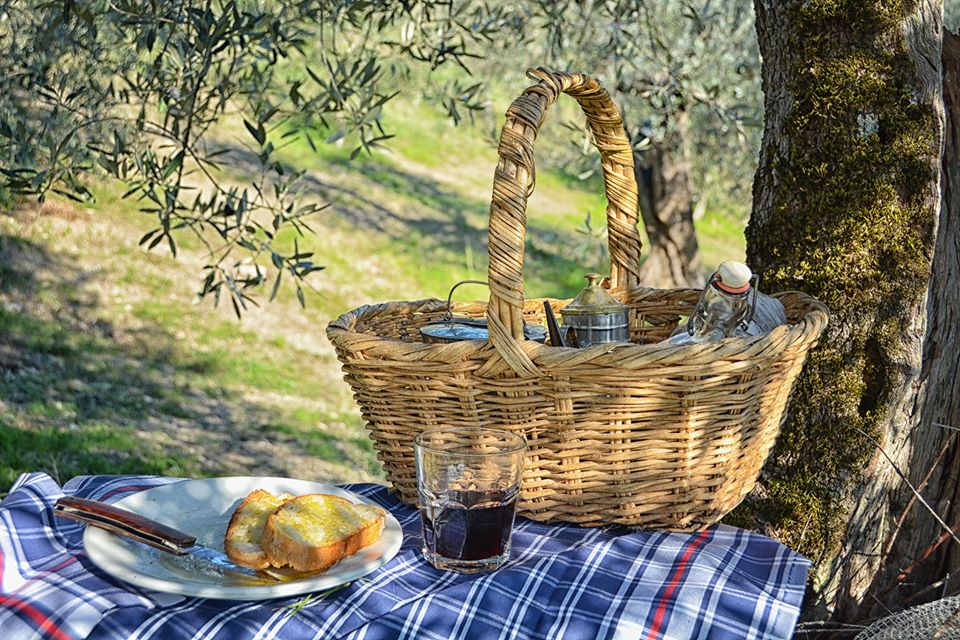
Fettunta can be also a great snack! Have a picnic under our olive trees with fettunta and red wine! Foto: Antonietta Bacci
Finocchiona “sbriciolona”
Finocchiona has an unmistakable aroma! It is a typical Tuscan sausage made from ground pork, flavored with fennel seeds, and wet with red wine. It seems that even Renaissance political philosopher and statesman Niccolò Machiavelli was fond of it! Its origin dates back to a time when meat could quickly spoil if not preserved with salt or dried. So, to pass off almost spoiled meat as good, some butchers thought of confusing customers by mixing fennel seeds, which are very aromatic, into the meat. Obviously, now this salami is produced following strict hygiene rules. A variant is called "sbriciolona" because it crumbles when cut. It is widespread in the Chianti Classico area, so much so that two Florentine municipalities, Campi Bisenzio and Greve in Chianti, claim its paternity.

Finocchiona toscana
Lardo di Colonnata
Colonnata is a tiny village in the mountains of the Apuan Alps a few kilometers from Carrara, reachable by winding roads with an incredible small central square, Piazza Palestro, all paved with Carrara marble and with a plaque in memory of the anarchists "killed on the road to Freedom." Lardo di Colonnata is an IGP salami, that is, a Protected Geographical Indication product (it identifies a product originating in a region and a country whose qualities, reputation, recipe, and characteristics can be traced back to the geographical origin, and of which at least one phase of production and/or processing and/or elaboration takes place in the delimited area). Its particularity is that the seasoning takes place in marble tubs from Carrara rubbed with garlic, with alternating layers of pepper, cinnamon, cloves, coriander, sage, and rosemary. This seasoning, which lasts between 6 and 10 months, gives the lard a unique organoleptic characteristic. It can be used as an ingredient in meat and fish dishes. From Tuscany, I like simple things, and for me, a slice of Colonnata lard melting on a piece of warm bread is excellent.
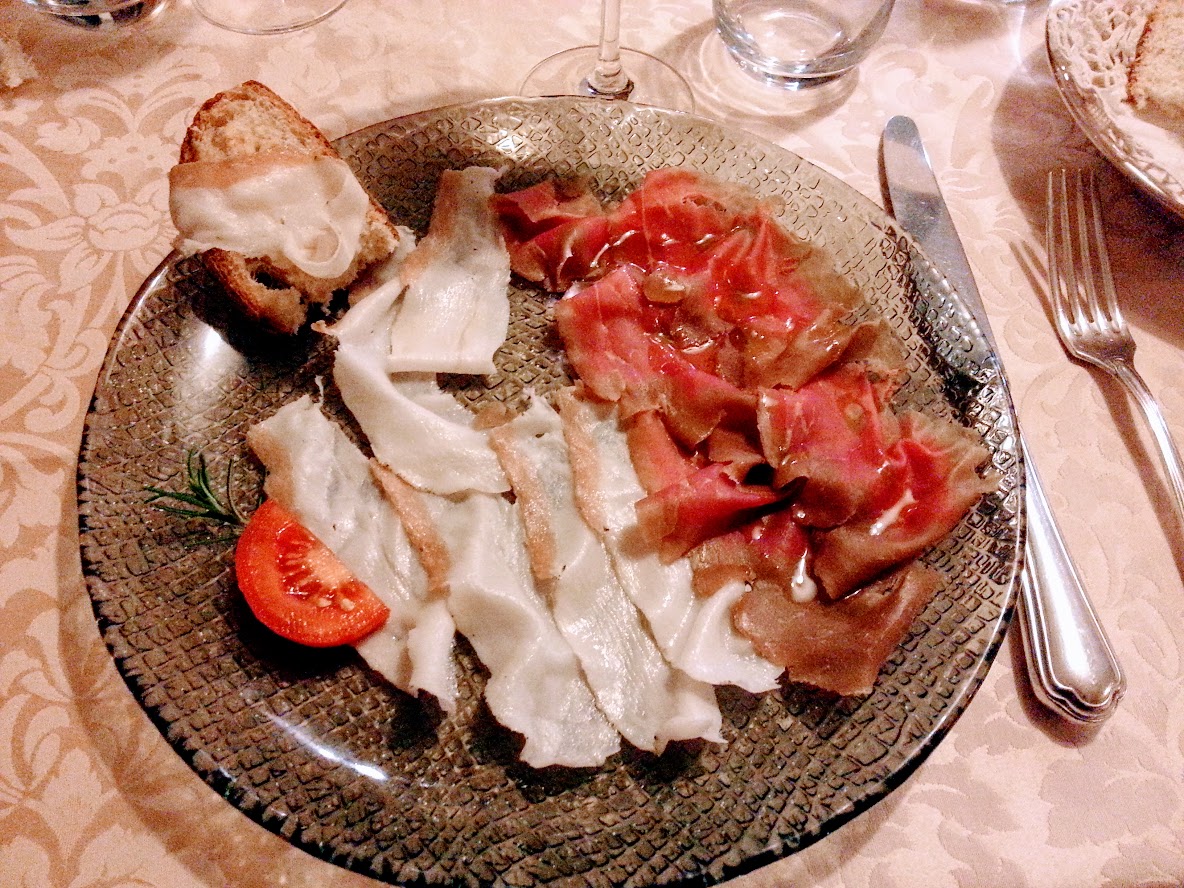
I had a memorable dish of Lardo di Colonnata at Ristorante Venenzio in Colonnata
Panigacci
What are Panigacci? Panigacci originate from the Lunigiana area and particularly from the town of Podenzana, home to a restaurateurs consortium. Panigacci are an ancient and simple food, whose dough is composed of water, wheat flour, and salt. However, making them at home is a bit complicated since terracotta disks are used (see photo) stacked and placed in the wood oven!

The terracotta disks ready to be cooked

Panigacci are now ready to be eaten
Fortunately, now to enjoy these specialties, it is not necessary to go to restaurants or the "panigaccio festival" in Podenzana; they can also be purchased at the supermarket, in vacuum-sealed packages. Some cook them in boiling water and season them with good basil pesto or other sauces, like testaroli. I prefer to consume them as a second course, well-heated in the oven or toaster (just 3 minutes are enough), and accompanied by cold cuts and soft cheeses. Fold the still-warm panigaccio in half and stuff it with your favorite ingredients, like a sandwich. I had olives, Tuscan salami, smoked cheese nuggets, small sausages, and buffalo burrata mozzarella at home when I took this photo.
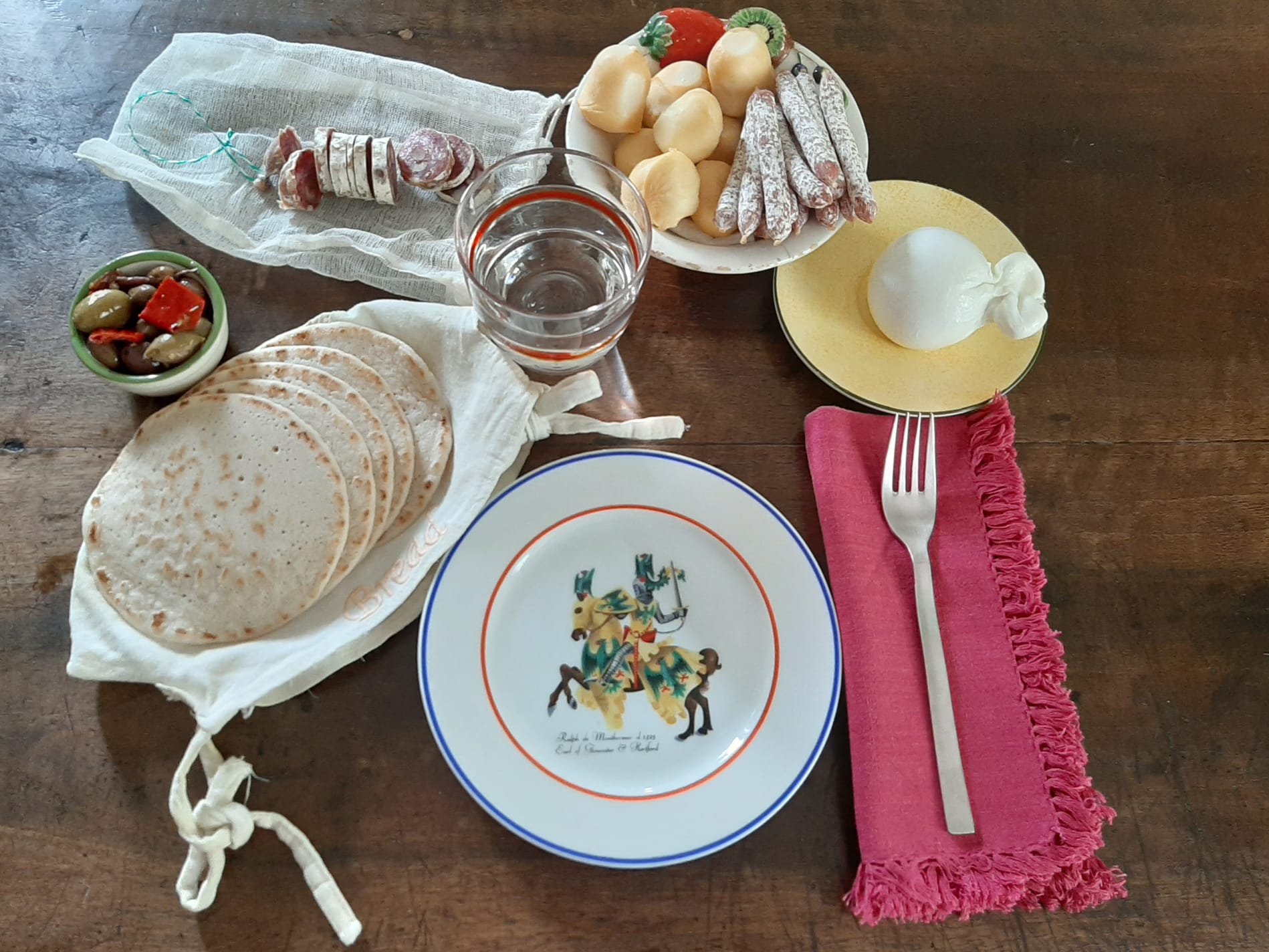
Panigacci are a great snack
Prosciutto toscano DOP - Tuscan DOP Ham
Tuscan Ham is a Protected Designation of Origin (DOP) product. It is a ham saltier than the equally famous Parma Ham, as it is seasoned by covering it with salt and pepper. Since ancient times, farmers in winter would slaughter animals fattened for a year to produce cured meats for the family, a festive tradition that has almost reached our days. The custom is so ancient that in the 15th century, during the time of the Medici, the production of Tuscan ham was regulated for the entire production process. The regulation was already so good that the current production specifications mirror those of the Medici era! The production process of Tuscan ham stipulates that after at least 12 months of seasoning, the product is checked and, if suitable, branded with the "DOP" logo using a firebrand. The DOP mark is regulated by European legislation and indicates a typical local product that adheres to a certain type of processing and occurs in a well-defined territory, linked to various historical and traditional factors.
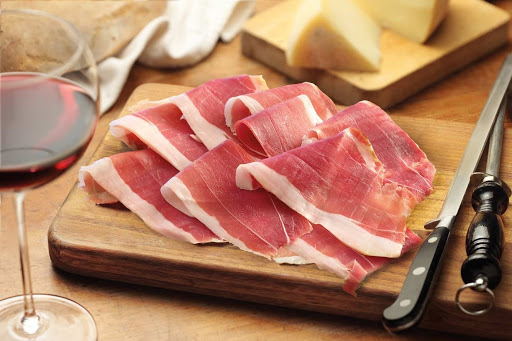
Prosciutto toscano DOP
Tuscan Salami
There are salamis of various sizes and lengths, but they all share the same characteristic: the fatty part is ground into large pieces. The lean part is obtained from the thighs and shoulders of the pig, while the fatty part comes from the back. The lean part is minced and left to rest for about 3 days at 0 degrees, then combined with cubes of fat. The resulting mixture is flavored with salt, pepper, and natural aromas. The stuffing is done in natural casings, and the aging, which lasts about 5 months, must take place in special premises, at a temperature between 10 and 12 degrees. It is a sausage with a delicate and flavorful taste.

Salame toscano
Soppressata
We have a saying, "nothing is wasted from the pig." And some of the products made with the poorest scraps of the pig, especially from the head (tongue, cheek, cartilaginous parts) and the tail, amalgamated with rinds (fattier parts of the pig), have a delicious taste. The mixture is softened with various spices, and to give a fresh note, lemon or orange zest is also added. It is also served in salads accompanied by raw vegetables such as fennel, carrots, and celery, thinly sliced.

Soppressata toscana
Tuna
Ah, finally a fish dish! But if there is no sea in Chianti, how is it possible to have tuna? Today, we live in a global world where, unfortunately, we can eat more or less the same things wherever we are. But let's not forget that until a few years ago, most people didn't travel much, and foods that came "from afar" could also be quite expensive. I believe my grandparents only knew tuna from a can! So, what is Chianti Tuna? Nothing more than another "poor" Tuscan dish with an exotic name; this tuna has never even seen the sea! The main ingredient is, in fact, pork meat (loin or shoulder or thigh). The piece of meat is salted for about three days, then cooked for about 5 hours with water, white wine, herbs, and spices (bay leaves, juniper, peppercorns, and rosemary). Once cooked, the hand-shredded meat is placed under oil (an excellent preservative, used since ancient times, the acidity of the oil keeps bacteria away) in sterilized glass jars. With this process, the pork meat takes on a very delicate flavor and a tender consistency that earned it the name "Chianti Tuna." An excellent summer dish, Chianti Tuna is served cold, perhaps accompanied by cannellini beans and fresh onions.

Chianti Tuna
FIRST COURSES
Gnudi o malfatti VEGETARIANO
In Florence, they are called Gnudi, in Siena, Malfatti, but everywhere they are delicious. They are simply the classic filling of ravioli without the pasta! Another straightforward dish with very few ingredients. Squeeze and chop thoroughly some precooked spinach. Mix them in a bowl with ricotta, an egg, a little flour, grated cheese, a pinch of salt, and a grating of nutmeg. Work the ingredients well, and when the mixture is compact, shape it into uniform balls using a teaspoon. Let them rest on a cutting board with a sprinkle of all-purpose flour. Bring water to a boil, add salt and a drizzle of olive oil to prevent sticking. Cook for 2-3 minutes, drain, and serve them piping hot, dressed with extra virgin olive oil and a sprinkle of good cheese.

Gnudi toscani, AKA malfatti
Tomato bread soup
A summer classic! The ingredients are simple: stale bread, tomatoes, extra virgin olive oil, garlic, basil, and salt. All ingredients easily found in the gardens and homes of traditional Tuscan farmers. Prepare a vegetable broth with vegetables (celery, carrot, onion, a few cherry tomatoes, and some parsley) in cold water. In a pan, sauté garlic cloves in extra virgin olive oil; when they are golden, add peeled tomatoes and some chopped basil. Cook for about ten minutes, crushing the tomatoes with a fork and adjusting with salt and pepper. Cut the stale bread. If you don't like garlic, remove the cloves from the sauce. While the broth is still hot, "stretch" the sauce, adding bread and basil. Let the pan simmer for another ten minutes, stirring occasionally. I prefer it when the result is not too liquid, and I can recognize the texture of the bread crust. Turn off the heat, let it rest for an hour. Serve hot, cold, or lukewarm with a drizzle of extra virgin olive oil. And of course, sing “Viva la pappa col pomodoro” during preparation!

Pappa col pomodoro
Pappardelle with Wild Boar Sauce
This dish isn't improvised! The night before, take the wild boar meat out of the freezer (where it has been for at least a week), a process to break down the meat fibers, naturally tough. Marinate the wild boar meat (leave it in the refrigerator in a bowl with a liter of red wine, an onion, a carrot, a stalk of celery, a garlic clove, and spices like cloves, pepper, and/or juniper berries) for an entire night. In the morning, squeeze it and start working it according to the recipe. Once cut into chunks, cook it in a pot on a base of sautéed vegetables. Add tomatoes and water, and let it simmer gently for at least three hours. Adjust the salt and cook the pappardelle in plenty of salted water, drain them al dente, and toss them in the wild boar sauce.
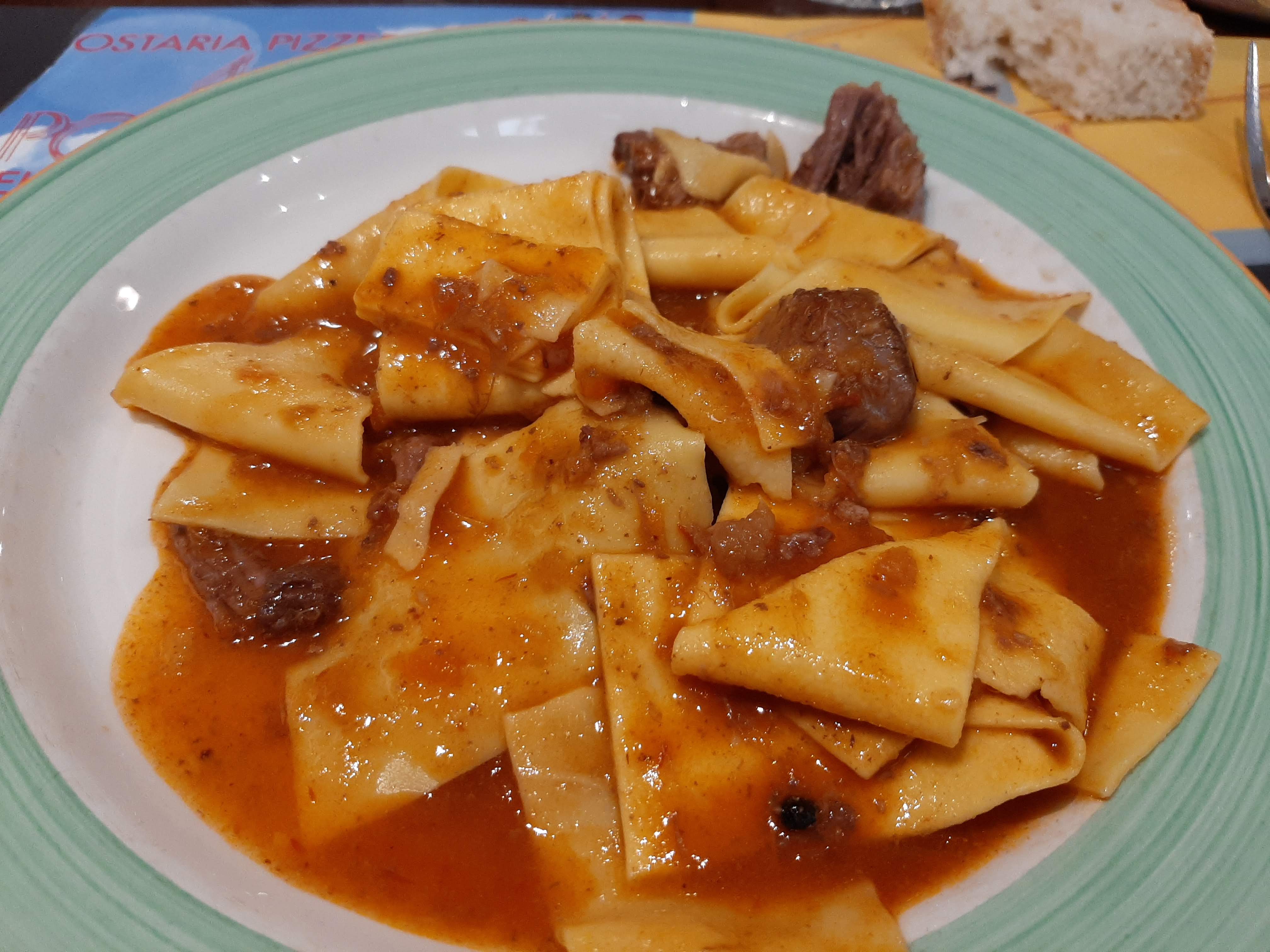
Pappardelle with Wild Boar Sauce - Osteria dei Centopoveri Via Palazzuolo, 31r Firenze
Panzanella VEGAN
An alternative to tomato bread soup that requires no cooking. Ideal on extremely hot summer days when the mere idea of lighting the stove makes us even hotter. A dish even mentioned by Boccaccio in the Decameron, calling it "pan lavato" (washed bread). Let's see why! The recipe is very simple. Slice stale bread and soak the slices for about ten minutes, then squeeze the bread well. Add the other ingredients (directly from the garden if you are lucky): tomatoes, cucumbers, and red onions cut to taste, basil, extra virgin olive oil, a little red wine vinegar, and salt. The dish is ready!
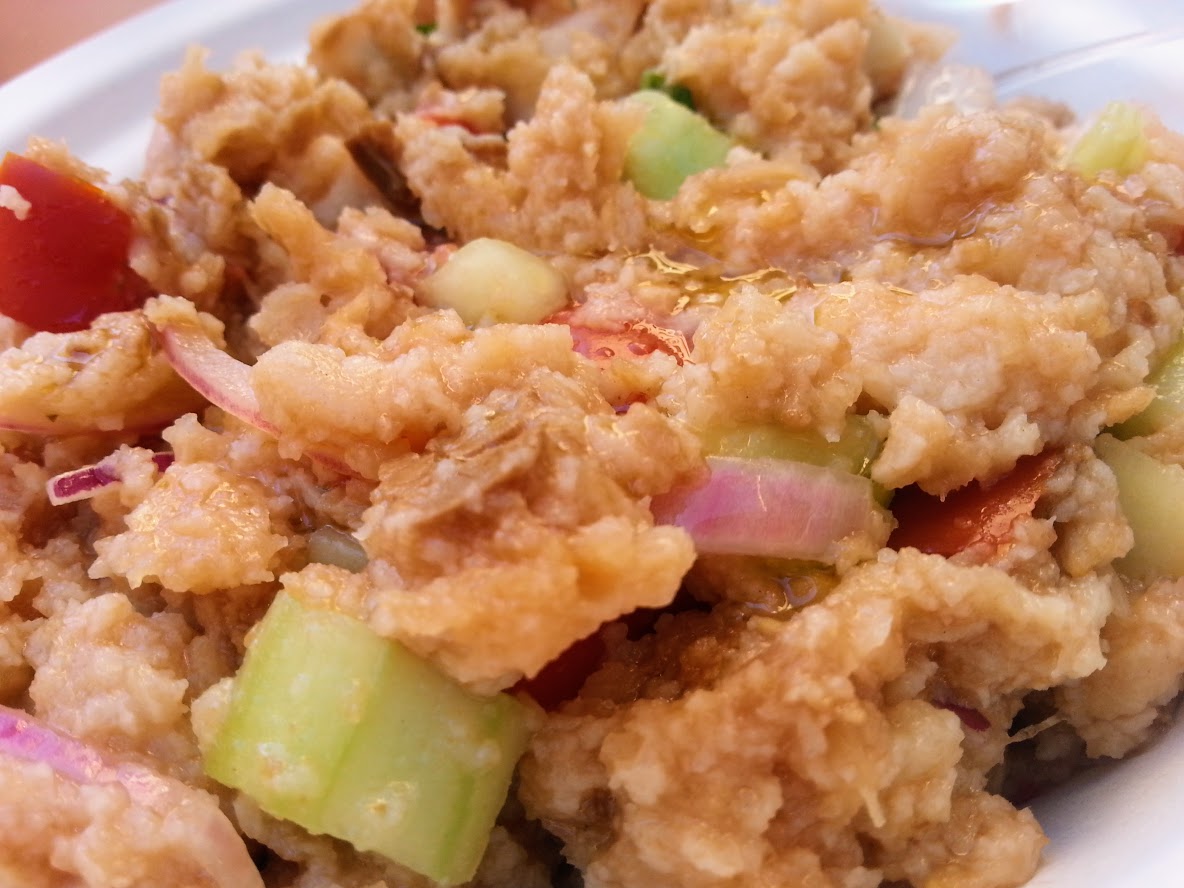
Panzanella
Pici
Pici are a humble and rustic pasta. My Aunt Fosca makes them (she also calls them "lunghetti"), and I managed to get the recipe from her. Keep in mind that each homemaker has their recipe, which can change based on pantry contents, and the quantities are often estimated ("a occhio" - by eye). My aunt is almost 90 years old, and I don't argue with her; we do it as she says: 200 grams of semolina flour mixed with 100 grams of all-purpose flour, warm water (my aunt boils it and then lets it cool slightly), extra virgin olive oil, 1 egg, salt to taste. Knead until you form a dough, let it rest for an hour. Flatten the dough with a rolling pin to about a centimeter, then cut it into strips about a centimeter wide. Take the end of a strip with the fingers of your left hand, lifting it slightly from the countertop. With the palm of your right hand, roll it while pulling gently with the left to elongate it. If all goes well, you'll end up with thick spaghetti. Boil them in plenty of salted water, adding a tablespoon of extra virgin olive oil to prevent sticking (6-8 minutes). Drain them al dente, toss them in the pan with the preheated sauce, turning or tossing them briefly.

Handmade Pici - Typical Tuscan Dish
Pici cacio e pepe
This sauce, inherently simple and rustic, has come back into fashion in recent years. Prepare a base of Pecorino flakes in a large pan, heating them with extra virgin olive oil, a bit of pepper, add some milk, just enough to amalgamate the Pecorino. Add the pici, a pinch of pepper, sprinkle with grated Parmesan, and add some Pecorino flakes. Serve them piping hot, I insist!
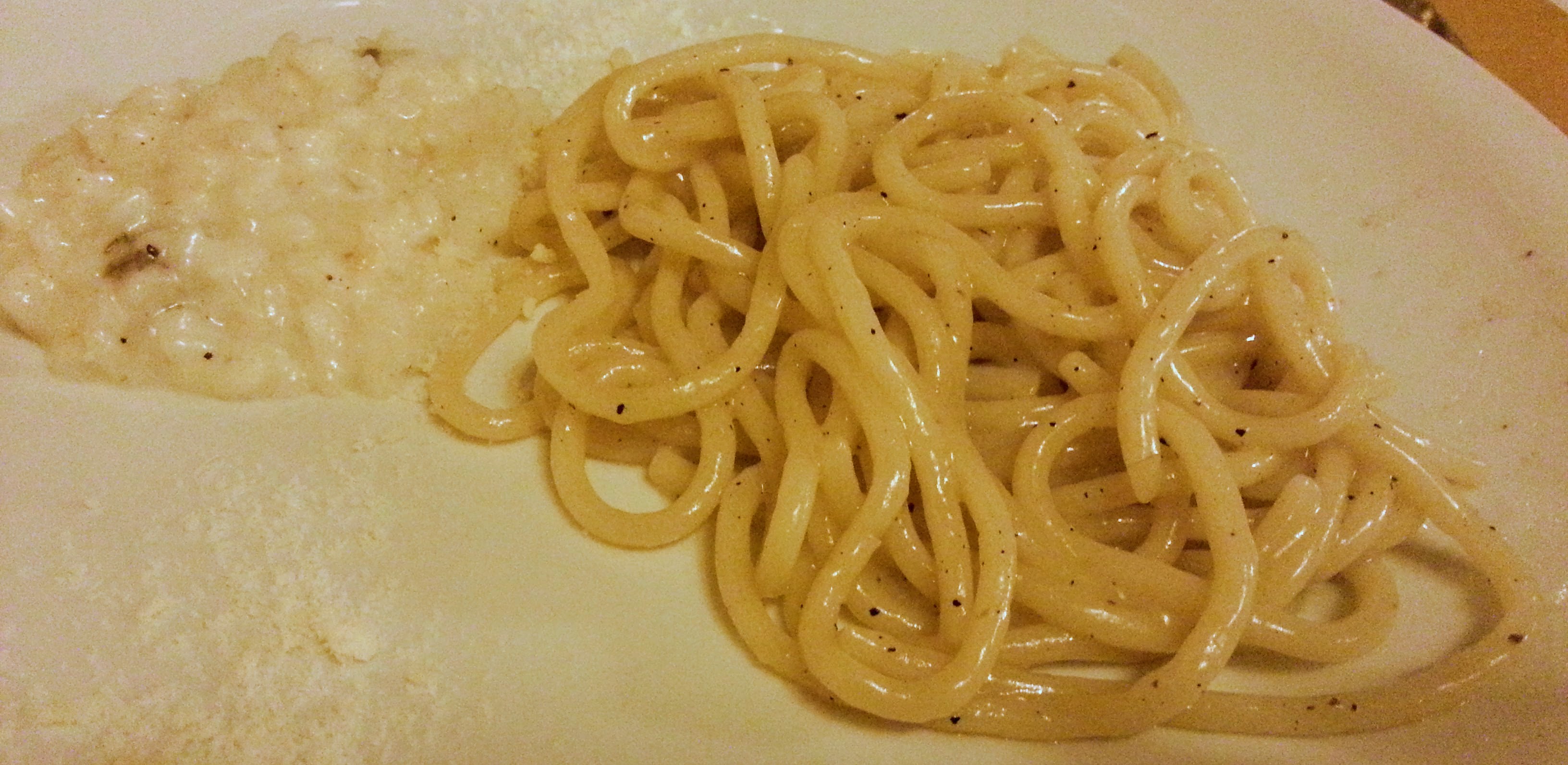
Pici cacio e pepe
Pici all’Aglione
Pici all'Aglione is a highly representative first course of the "poor" Tuscan tradition, especially in the Val di Chiana. Basic and common are the ingredients on our tables: extra virgin olive oil, Aglione from Chiana (a variety of garlic rediscovered relatively recently, larger and less pungent than common garlic), tomatoes (better if freshly picked from the garden), a little white wine, salt. Take a nice pan that can hold all the ingredients. Pour 4 or 5 tablespoons of extra virgin olive oil, add crushed Aglione and half a glass of white wine (if you don't like wine, you can dilute the sauce with water). Cover the pan and cook over moderate heat for about fifteen minutes. Crush the Aglione again (it should be well minced), add the tomatoes, and adjust the salt. Cook over low heat until the sauce reaches the desired consistency. There is also a version for those who want to feel only the scent of Aglione. Follow the recipe, leaving the Aglione whole, so you can easily remove it.
![]()

Pici all'aglione
Ribollita VEGAN
Tomato bread soup is to summer as Ribollita is to winter! It is a soup whose ingredients were simply what was available during winters of the past. Fundamental is the black cabbage that should have experienced a frost! Soak the Zolfini beans for 12 hours, then put them in a pot with cold water, a clove of garlic, and a stalk of celery. Cook over low heat and occasionally top up with boiling water. Blanch the black cabbage leaves in a little water, roughly chop them, and put them in a pan with chopped celery, a potato sliced, two carrots in rounds, 6 or 7 tomatoes cut into 4 parts, and extra virgin olive oil. Sauté for a couple of minutes, then add a ladle of bean boiling water and let it simmer for half an hour. Return to the pot of beans. After a couple of hours, pass half of the beans, leaving the other half warm on the side. Put their water in the pan where the vegetables are cooking and let it simmer for another half hour. In another terracotta pan, moisten with broth, place slices of bread, some whole beans, some vegetables, slices of bread, and so on. Now decide whether to put this second pan in the oven at 130 degrees for 30 minutes, keeping it covered, or for three-quarters of an hour on very low heat. Ribollita is eaten hot or warm and must be dense and enveloping. It owes its name to the fact that once peasant families were very numerous, and there were many tasks to be done both at home and outside. So on Fridays, a fasting day, Ribollita was prepared in large quantities and then consumed in the following days. To reheat it, it was boiled again.

Ribollita toscana
Testaroli VEGAN
An ancient pasta, born in Lunigiana (northwest Tuscany). Those who wish to buy it already made will have no trouble identifying the typical giant round packages, so large that they are sold rolled up, at the market or supermarket (now much more common than before). More practical packages are also available, with Testaroli already cut irregularly. The ingredients are very simple: flour, water, and salt. They are called Testaroli because the first cooking of the dough takes place in a "testo" (once made of clay, now cast iron), and once ready, they look like thin, porous disks of pasta. Then it is cut into pieces and cooked in water. Their porosity allows them to absorb the sauce very well. Being a typical dish of Garfagnana and Lunigiana, accompanying sauces include mushrooms, walnuts (pound 2 grains of coarse salt, walnuts, a little basil, cheese, and extra virgin olive oil) or basil pesto, as used in neighboring Liguria, or a mushroom sauce. A huge advantage of Testaroli is that they cook in very little time, only THIRTY seconds. So they are ideal for satisfying the hunger of impatient, screaming children.

Testaroli with Pesto, Tiziana's style
MAIN COURSES
Florentine Steak
It always makes me smile when I read that the steak is a typical dish of the Tuscan tradition. Let me clarify. I accept (with thinly veiled enthusiasm) that this dish is very Tuscan (I tend not to order it outside Tuscany), but I can't help thinking that my grandparents, their parents, and their grandparents really rarely ate steak, perhaps never. It was a dish for the wealthy; farmers certainly couldn't afford meat, nor could small artisans. The Florentine steak must have specific characteristics. It must be at least 3 fingers high, preferably 4 (minimum 5 or 6 centimeters), with the fillet, aged for 4 weeks. No marinade, no poking, cooked rare (two things. If you are at a restaurant and the waiter asks how you want it cooked, run away immediately, and NEVER insist on having it medium or "well done"). Season it with salt, pepper (some even juniper), and extra virgin olive oil raw at the time of serving. In a restaurant, it should be shown at the table before cooking, and it would be good if a receipt certifying the weight of the steak were released at the table. A well-cooked Florentine steak should not remain cold inside but reach an internal temperature of 37/38°C. A good chef understands how many minutes a steak needs to cook and how long it should rest, standing in the warmth near the fire. The Florentine steak requires long chewing, which prolongs mastication, increases salivation, compensated by the tannin in red wine, drying the mouth. Hence the explanation for the pairing of Florentine steak and Chianti. The cattle breeds commonly used by Florentine restaurateurs for the Florentine steak are: Limousine (retail price around 45 euros per kg), Chianina (retail price around 55 euros per kg), Maremmana, Scottona, Croata (retail price around 48 euros per kg).

Florentine Steak at Ristorante Coco Lezzone in Florence
Fegatelli fucecchiesi
Fegatelli are prepared throughout Tuscany, being a dish of peasant origin, with many variations linked to the territory and what it offers. In Fucecchio, they are prepared by skewering the pork not minced but cut into chunks with a sprig of fennel. Pork liver is used, as well as lean meat and lard, following the peasant tradition. Even today, it remains an indispensable dish of typical Tuscan cuisine. Prepare a minced mixture with garlic, sage, and fennel flowers. Add salt and pepper, mixing well. Roll the pieces of liver and lean meat in this seasoning, forming each "fegatello" with two pieces of lean pork with a piece of liver in the middle. The meat is held together, as if it were a skewer, by a sprig of wild fennel. Melt the lard to heat in a terracotta or steel pan and then immerse the "fegatelli" so that they remain covered, and only the sprig comes out. As soon as it starts to boil, lower the flame and cook over moderate heat for about half an hour. If not consumed immediately, "fegatelli" have the characteristic of keeping for a long time under lard (which is a preservative) for about a month at room temperature and even a year in the refrigerator.
Francesina/Lesso rifatto
The "francesina" is another recycled dish, typical of Tuscan gastronomy. This time it does not involve the use of stale bread, although dipping the bread in the "francesina" is one of the things I like most! The "francesina" is simply prepared by cutting pieces of boiled beef (excluding waste). Skin, cut in half, and slice not too thinly the onions. The preparation of the "francesina" starts precisely from the onions. Put a pan on the fire with extra virgin olive oil, add the onions, adjust the salt, cover, and lower the flame. Check often; the onions should cook well, not burn! You can also add a little water if you think it's necessary. When the onions have become transparent and reduced in volume, add roughly processed peeled tomatoes with a fork and a couple of bay leaves. Raise the flame, cook for 5 minutes, and then add the meat. Now lower the flame, adjust with pepper, and let it go for about ten minutes after adding some broth. Serve hot, but it's also delicious cold. Like any respectable poor cuisine dish, the recipe is influenced by hunger, mouths to feed, and what we have in the pantry. The variant with potatoes is also widespread.
Mallard of the Padule di Fucecchio in Stew
Fucecchio gives its name to the largest internal wetland in Italy, the Padule di Fucecchio, a spectacular area reclaimed by Pietro Leopoldo of Habsburg-Lorraine, Grand Duke of Tuscany, later Emperor of the Holy Roman Empire as Leopold II. The Padule di Fucecchio is a rich territory that hosts numerous species of flora and fauna. The mallard bird is the symbol of the Fucecchio Marsh, along with the teal and the pochard. Cooked, it is still today a delicious dish that can be found in some trattorias.
To prepare it, we need to flame the mallard, gut it while preserving the liver, and cut it into pieces. Put a pan on the fire with Tuscan extra virgin olive oil, a mixture of celery, onion, garlic, rosemary, sage, and parsley. Ignite the fire, as soon as the mixture begins to wilt, add the mallard and the liver. Adjust with salt and pepper and let it brown well over moderate heat, adding hot broth if the meat should dry out. After about a quarter of an hour, add a glass of red wine, let it evaporate, and add tomato diluted with a cup of hot water. Continue cooking for about an hour, always over moderate heat. Shortly before finishing cooking, remove some pieces of mallard and chop them together with the liver with the crescent, then put everything back in the pan to complete the cooking. This way, we'll have the sauce for the first course, for example, egg tagliatelle, and the second, served with the cooking broth.
Rosticciana
The rosticciana (or rostinciana) is simply a strip of pork ribs cooked on the grill, brushed with extra virgin olive oil using a sprig of rosemary as a brush. That's it; then, when cooked, it is divided into individual ribs.
Tripe
Another exquisite dish, typical of Tuscan cuisine, with an ingredient of scraps appreciated since the times of the Greeks and Romans. Tripe, or rather "trippe" as more correctly stated in other parts of Italy, makes up the digestive system of slaughtered cattle, divided into four parts: three fore-stomachs (rumen, reticulum, and omasum) and the actual stomach (abomasum). The typical lampredotto of Florence is made with abomasum, while Florentine tripe is made with rumen. Fundamental for the excellent outcome of this very delicious dish is the raw material. In markets and butchers, most Tuscan housewives who know how to work with it use pre-cut and precooked white tripe (grandmothers used semi-prepared whole tripe, perhaps tastier but longer to prepare; nowadays, the conservation chain is crucial, and precooking ensures greater hygiene). Florentine tripe is prepared by cutting the tripe into small strips after washing it thoroughly with water and lemon. We make the usual sauté with a mixture of onions, garlic, celery, and carrots with extra virgin olive oil; add the tripe, then peeled tomatoes and let it cook very slowly for about an hour until the tripe and tomato water evaporate, leaving a sauce with a delightful consistency. Adjust with salt and pepper. Legend has it that Florentine tripe is even better the next day. I'm not saying it's not true; I'm just saying it's an experience I've never had! A myth to debunk: tripe is not fatty. In fact, 100 grams contain just over 100 calories. Uh, even though a sprinkle of good cheese on top is just right...

Florentine tripe at Osteria dei Centopoveri Via Palazzuolo, 31r Firenze
ONE-DISCH MEALS
Cacciucco
A typical fish soup from Livorno, but there is also a version from Viareggio. Poor fish soup, including shellfish and mollusks, usually octopus, cuttlefish, mantis shrimp, red scorpionfish, with the addition of tomato sauce and wine, originated from the fish that remained unsold on the port stalls. The real "cacciucco" has little pulp; it is a challenging dish to propose today. The Livornese version includes rock fish, while the Viareggio one involves sandy fish. Livorno's "cacciucco" has a more robust flavor, made with a sauté, with garlic so that the fish does not fillet, and wine is also used in cooking. Viareggio's is lighter, no sauté, no garlic, and all the fish is filleted. In Livorno, it is mandatory to accompany it with red wine, while in Viareggio, white wine is also allowed. Both versions are enjoyed by serving the soup in a bowl with slices of stale bread (and, in Livorno, garlic bread).

Livornese Cacciucco at Cantina Senese in Livorno
Lampredotto

As proof that traditional Tuscan cuisine is poor, made from scraps, leftover bread, and less prized parts, lampredotto has always been the prince of Florentine street food. Around Florence, there are kiosks and stalls that successfully offer this tasty sandwich to both Florentines and tourists. A very poor dish, lampredotto is the result of prolonged boiling of one of the four stomachs of cattle. Read like this, it might not make much sense, but the cooking really tempers its taste. In fact, it is boiled in water with tomatoes, onions, parsley, and celery. In lampredotto kiosks, we can enjoy it plain, with green parsley sauce, or with red sauce, a bit spicier. It is served in a bun soaked in broth, placed in a practical anti-stain paper bag.
DESSERTS AND SWEETS
Brutti ma buoni ai pinoli
Also known as Kinzica, the "ugly but good with pine nuts" are small pastries shaped like balls, made with pine nut paste. They are very soft and spongy, externally dusted with powdered sugar and covered with whole pine nuts all over their surface. As the name Kinzica suggests (the sleepless Pisan princess Kinzica dei Sismondi in a night in the year 1404 saved Pisa from Saracen pirates by spotting their boats off the city of the leaning tower), this sweet is typical of the province of Pisa (the Pisan pine nut from the Parco di Migliarino San Rossore, fruit from domestic pine trees in the Mediterranean scrub, which gives the sweet a particular flavor and resin aroma, is particularly valuable and appreciated for its elongated shape) but also in Fucecchio.

Kinzica Pastries, made by Simone Bernardini Bakery in Fucecchio (with good pine nuts!)
Brigidini from Lamporecchio
Brigidini from Lamporecchio, for me, signify fair and festival. They are golden yellow wafers, folded like leaves, thin and about 6 centimeters wide. The ingredients are sugar, flour, eggs, and anise essence, giving them their characteristic flavor. They owe their name to the nuns of the Santa Brigida convent in Pistoia, who invented them in the mid-16th century. Now easily available even in supermarkets, you can recognize them because they are packaged in a long transparent plastic bag. It is very entertaining to see them being prepared in front of our eyes at country fairs, festivals, and markets. Nowadays, they are made by a machine that presses a certain amount of dough onto a hot aluminum mold with a characteristic raised design. A paddle curls the wafers, already cooked but still soft, so there is no brigidino identical to another!
Almond Cantuccini
Cantucci, cantuccini, or Prato biscuits, call them what you want, are always good. They are twice-baked ("bis-cotti"), as they undergo an initial baking by combining the ingredients (flour, sugar, eggs, whole unpeeled almonds, and olive oil or honey) and forming a small log that is partially baked. It is then removed from the oven and sliced into thick finger-shaped pieces. The final cooking is done by baking the individual biscuits. Good on their own, they can be a bit hard at times. To overcome this inconvenience, they are dipped in a liqueur wine, another Tuscan specialty, Vin Santo (Vin Santo has nothing to do with the Church and its Saints. According to some, the name derives from an event during the Council of Florence in 1439 when the Greek metropolitan Giovanni Bessarione drank a cup of "Vin Pretto" - straight, not diluted - and exclaimed: "This is the wine of Xantos!". Perhaps the taste reminded him of the fortified wine of Santorini, made with pressed sultana grapes. A little curiosity: sometimes we find written "Vin Santo di Caratello". The "caratello" is a barrel of 100 liters).
Almond Cantuccini home made by my friend Stefania Fierli
Castagnaccio
The very word "castagnaccio" evokes autumn and the first cold. This typical sweet, which my grandmother called "migliaccio," provides a good energy boost and is straightforward to make. Mix chestnut flour, water, extra virgin olive oil, and pine nuts into a liquid batter, spread a baking pan with extra virgin olive oil, and then pour the batter. Bake in a hot oven. The ideal castagnaccio is crispy on top and bottom and soft inside. In the Florence, Siena, and Chianti area, the traditional recipe also includes rosemary. Nowadays, it is often served with spread ricotta on top.

Tuscan Castagnaccio
Close relatives of castagnaccio are Patona or Castignà from Lunigiana (similar but thinner), necci (pancakes folded in half and filled with ricotta), popular in Lucca and Pistoia, and toppone from Livorno (coarser, taller, and used more to fill the stomach inexpensively).
Cavallucci
Cavallucci have this romantic name because it is said that they were eaten at postal stations when travelers and couriers stopped to change horses. Cavallucci from Siena are typical sweets of the Tuscan Christmas tradition. They are cookies made with flour, sugar, and honey, sometimes enriched with walnuts, candied fruit, and various spices. They are not elegant, have a chunky shape, but they are good and taste like family! They are usually a bit hard, so they are an excellent excuse to accompany them with a small glass of Vin Santo.
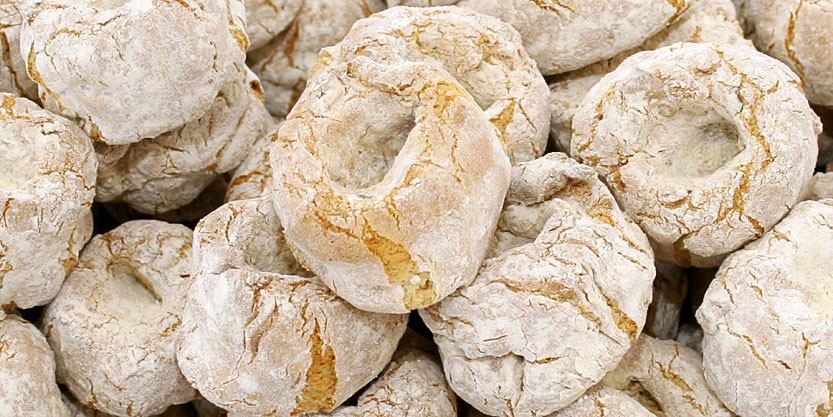
Cavallucci at Panetteria Simone Bernardini in Fucecchio
Siena Panforte
Panforte is a typical sweet from Siena, strongly associated with the Christmas season. It has very ancient origins, dating back to at least around the year 1000 AD, and was called "Pane Natalizio," "Pane Aromatico," or "Pan Pepatus" (because it was completely covered with spices and ground pepper). It is a rich dessert, made from precious and highly nutritious ingredients (orange, citron, melon, almonds, spices). So much so that it was prepared by apothecaries for rich markets, nobles, and members of the clergy. The name Panforte is thought to derive from the "strong" taste of the sweet. In the past, the fruit was dried in the sun. If the preparation was not perfect and the fruit was not completely dry, it could happen that the fruit continued to ripen and spoil, giving the Panforte a slightly acidic taste. This was overcome by adding abundant doses of spices and pepper. During Italy's Regina Margherita's visit to Siena in 1879, a more refined panforte was produced. This version was dusted with powdered sugar instead of pepper and without melon. It looks like Regina Margherita was totally captivated, and not only her, since then the modified recipe has become the traditional Margherita panforte.

Siena Panforte at Panificio Simone Bernardini in Fucecchio
Ricciarelli
Ricciarelli from Siena are small almond-shaped sweets made from almond flour. The ingredients are simple: egg whites, lemon juice, powdered sugar, almond flour, bitter almond flavoring, a vanilla pod, and grated orange zest. The night before, beat the egg whites with a drop of lemon. Add powdered sugar, almond flour, bitter almond flavoring, vanilla seeds, and grated orange zest. Cover with plastic wrap and let it rest overnight in the fridge. The next day, shape the sausage from the dough on the work surface sprinkled with powdered sugar. Cut the sausage into slices. Work them with your hands to give an oval shape, about a centimeter thick, and place the future cookies on a baking sheet lined with parchment paper. Wet your hands and touch each ricciarello, moisten it, and then sprinkle it with powdered sugar. Cut the host of the typical ricciarello shape and place it under each cookie. Bake them in the oven for less than 20 minutes. They will still be soft when they come out of the oven, but once cool, they will be perfect. Despite what some say, that ricciarelli are good even after a few days, stored in a tin box, I definitely prefer them very fresh!

Ricciarellis
Florentine Schiacciata
Florentine Schiacciata is one of those flavors and scents that, just thinking about it, transports me to childhood. In those times, not all products were always available. Florentine Schiacciata meant one thing only: Carnival! With its unmistakable rectangular shape, entirely dusted with powdered sugar and featuring a large Florentine iris prominently displayed in cocoa powder. The recipe is very simple, although I've never had the courage to make it at home! Work the flour, sugar, eggs with the yeast dissolved in milk, and later add lard and a pinch of salt. When the dough is well worked, you'll have a soft but elastic mass. Let it rise, covered, until it doubles in volume. Pour the mixture into the baking pan lined with parchment paper and let it rest for another hour. Bake at 180°C for 30 minutes. I am indulgent, and nowadays, almost all Florentine Schiacciata is cut and filled with cream or whipped cream. But my favorite remains the one without filling, perhaps to be accompanied by a good Vin Santo.
Fucecchiese Easter Schiacciata
Fucecchio's Easter Schiacciata is a typical sweet that originated in the second half of the 19th century in the Fucecchio countryside and in the plain of the neighboring Pisan area. It was thought to prepare a sweet for Easter using the surplus of eggs during the Lenten period. The result is a very light and aromatic dessert. It is often enjoyed with a glass of Vin Santo.
Torta co’ bischeri
The Torta co' Bischeri has been a registered trademark owned by the municipalities of San Giuliano Terme and Vecchiano since April 2007, with its own specifications. Torta co' Bischeri is a cake with a typically round shape and unique folds on the edge, called "appunti bischeri." It has a shortcrust pastry base and a very rich filling made with chocolate, boiled rice, raisins, eggs, pine nuts, candied fruit, nutmeg, and liqueur. Torta co' Bischeri also has ancient origins, and it was prepared for pilgrims who came to venerate the Holy Crucifix of the Miracle (a 13th-century image located in the Church of San Michele Arcangelo in Pontasserchio).
Torta di Cecco
Similar but different from the fellow Panforte, Torta di Cecco has different ingredients (candied apricot and orange peels, as well as chopped almonds and hazelnuts, sugar, wheat flour, and spices). The delicious dark chocolate coating makes it even more tempting. The origin of the name is a bit hazy. In Siena, Francesco becomes Cecco, so it is whispered that the name is a tribute to the brilliant poet Francesco, called Cecco, Angiolieri, one of Siena's most famous sons. Born into a wealthy Guelph banking family, Cecco Angiolieri knew and associated with Dante Alighieri but led a unscrupulous life that led him to die deeply in debt. His works are still relevant today, with favorite themes being beautiful women, drinking, and gambling, all easily understandable. Here's some of his famous Rhymes:
S'i' fosse foco, ardere' il mondo;
If I were fire, I would burn the world;
s'i' fosse vento, lo tempestarei;
if I were wind, I would storm it;
s'i' fosse acqua, i' l'annegherei;
if I were water, I'd drown it;
s'i' fosse Dio, mandereil'en profondo;
if I were God, I'd send it to the deep;
s'i' fosse papa, serei allor giocondo,
if I were pope, I would then be joyful,
ché tutti cristïani embrigarei;
for I would intoxicate all Christians;
s'i' fosse 'mperator, sa' che farei?
if I were emperor, you know what I'd do?
a tutti mozzarei lo capo a tondo.
I'd behead everyone roundly.
S'i' fosse morte, andarei da mio padre;
If I were death, I would go to my father;
s'i' fosse vita, fuggirei da lui:
if I were life, I would flee from him:
similemente faria da mi' madre,
and I would do the same with my mother.
S'i' fosse Cecco, com'i' sono e fui,
If I were Cecco, as I am and was,
torrei le donne giovani e leggiadre:
I would take young and graceful women:
le vecchie e laide lasserei altrui.
the old and ugly I'd leave to others.
Connoisseurs recommend pairing Torta di Cecco, with its spicy flavor, with a good dessert wine, perhaps with a fruity aftertaste.
Fucecchio Carnival Sugar Bisquits
Fucecchio Carnival Sugar Bisquits have been Fucecchio's carnival sweet since the 19th century. They seem to be an invention of the peasant families in the Fucecchio countryside who made them for their children, hanging them on sticks in pantries to safeguard them from the children's gluttony (and perhaps from a few mice as well). They have two great merits: they keep for a long time since the dough is similar to that of a dry biscuit, and they are quite simple to make. Arrange the flour in a fountain shape and add sugar, eggs, grated butter, lemon, and orange zest, honey, a pinch of salt, a little extra virgin olive oil, a couple of small glasses of liquor, and two sachets of baking powder. Knead everything together, and once you have the dough, divide it into strips of about half a centimeter. Form small donuts with a diameter of 6-7 cm and bake in a moderate oven for about 10 minutes.
Florentine Zuccotto
Florentine Zuccotto is the king of desserts in Florence. Its origins date back to Caterina de' Medici, the queen consort of France, as the wife of Henry II. It seems to be the fruit of the ingenuity of Bernardo Buontalenti, the architect who invented the semifreddo, and the name "zuccotto" is said to come from the first mold used, a small spiked helmet called precisely "zuccotto" used by the infantry of the time. The recipe of the time was simple. A dome of soft sponge cake entirely soaked in alchermes (a liqueur we owe to Marco Polo, who reopened trade routes with the Arabs, suppliers of cochineal) that gave it the characteristic red color, and filled with ricotta with citrus zest from the Medici residences and cocoa nibs. Fallen into oblivion, it suddenly returned to fashion about ninety years ago.
English Trifle
English Trifle has this exotic name and mysterious origins. Among the many who claim its invention is also the city of Florence, or rather, the hills surrounding our capital. The adjective probably comes from a Renaissance English sweet called "trifle," made with cream and sponge cake all soaked in alcoholic beverages. Let's remember that in the second half of the 19th century, one-third of Florence's citizens were foreigners, most of whom were Anglo-Saxon (for simplicity, let's call them "English"). Many of these wealthy English had villas and houses in the countryside around Florence. It seems that a maid, not wanting to throw away tea biscuits and "English" custard, from these "leftovers" invented English Trifle. Making English Trifle is not difficult. In a mold, we must create layers alternating slices of sponge cake about half a centimeter thick and moistened with a little alchermes with a layer of custard, without flour. The more gluttonous also put drops of chocolate here and there. Continue until you run out of ingredients and let it rest in the fridge for a few hours. Excellent after dinner or as a snack.

